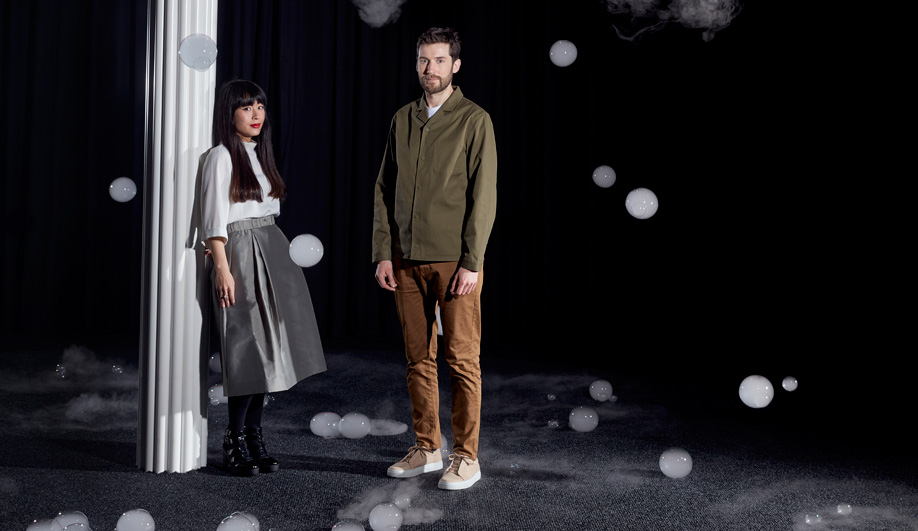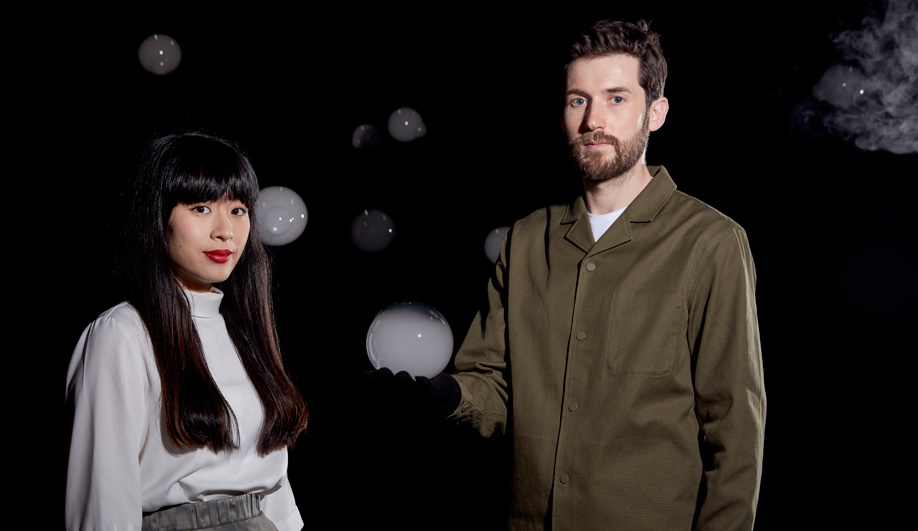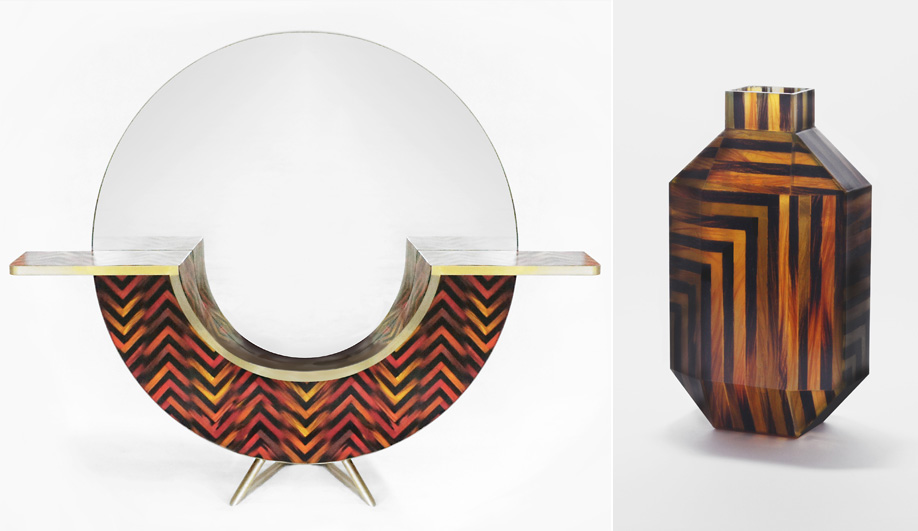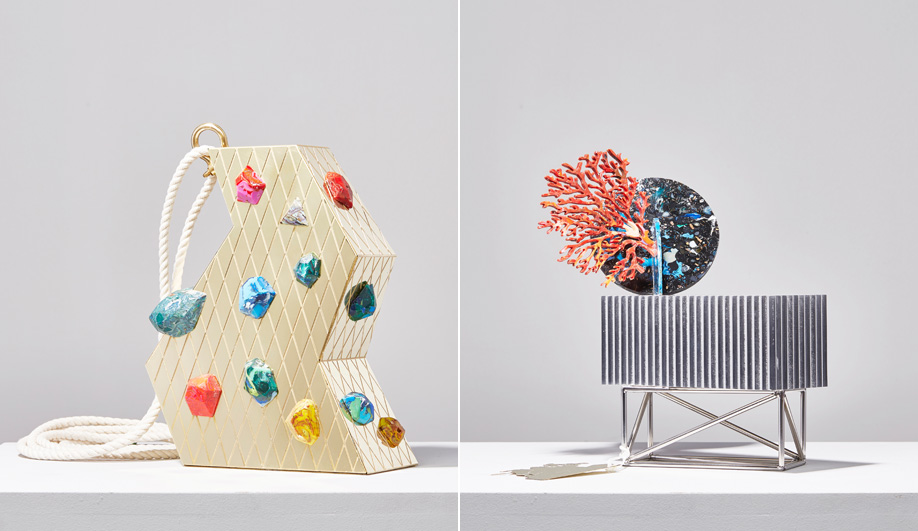
For Alexander Groves and Azusa Murakami of Studio Swine, design begins with investigation. Their experimental, often melancholic work seeks to uncover stories and feelings lost beneath the surface.
As you entered a darkened and atmospheric theatre at this year’s Milan Design Week, you were handed a single fabric glove. Inside the dim room was an illuminated white tree with curved branches producing lightly scented bubbles every eight seconds.
If you tried to catch them on your bare skin, they popped instantly, but if you were careful, you could hold one on a gloved hand for a few memorable moments. Alluringly simple yet deceptively rich and layered, New Spring – a poetic and sculptural collaboration by London-based Studio Swine and minimalist Scandi fashion brand COS – delighted young and old for what, in the social media age, felt like an eternity.
Founded by Japanese architect Azusa Murakami and British artist Alexander Groves, Studio Swine has made waves with its experimental, thoughtful and research-driven work exploring such diverse topics as marine waste, science fiction, the human hair industry in China and a forgotten city in the Amazon. For New Spring, the references the husband-and-wife duo drew on were equally wide-ranging and eclectic.
One source of inspiration, they tell me, was Italian cinema. Another was the mesmerizing fountains and rich public spaces of Italian cities. “One of the things we really love in Italy is this great sense of luxury you get in the public realm,” says Groves.
The tree also paid tribute to the large chandeliers found in Milanese palazzi as well as the tradition of modernist design born in the northern Italian city, exemplified by the Castiglioni brothers’ famous arched Arco floor lamp. The designers likened the evanescence of the water, air and vapour globules to the flowers of Japanese cherry trees that blossom for only one week a year. “We were interested in the melancholic side of the experience, this acknowledgement of the impermanence of things,” explains Groves.

This multi-faceted approach is typical of Murakami and Groves, who have an openness and curiosity toward other disciplines and materials. Groves studied fine arts at the Ruskin in Oxford, whereas Murakami – who moved from Japan to a U.K. boarding school at the age of 12 in a bid to “learn English and more about the world” – studied architecture at the Bartlett. They met while doing an M.A. in product design at London’s RCA, where the course proved rewarding but largely conceptual. “We are still just as bad at making things as before!” they both exclaim, laughing. Under the tutelage of the likes of Jurgen Bey and Tord Boontje, their eyes were opened “to how rich in narrative design is, and how it can engage with people and public space in a way that changes behaviour and perceptions.”
Studio Swine’s work is infused with this sense of narrative, driven by an almost archaeological approach and a desire to expose social and environmental problems. The duo’s 2012 Sea Chair project – which involved attaching to each chair the coordinates of where the plastic to make it was fished out – became not only an urgent comment on the “plastic soup” our oceans are fast becoming, but also a tangible way of honouring place. By making the chairs at sea, the designers also referenced the carpenters who travelled with sailors and whalers in order to repair ships; in their downtime, these carpenters would turn pieces of driftwood and whale tusks into boats and sculptures.
“In a way, what we do is a form of journalism, but the end result is an object,” explains Groves. Murakami agrees that there is an objectivity about their approach. “Often we don’t really have an opinion at the end of doing something, we just want to present people with an idea or expose something that hasn’t been seen this way before.”

Like old-school reporters, Murakami and Groves use as many analogue as digital sources, believing that “the best research isn’t necessarily possible through digital channels.” They knew they were on to a great story with the human hair industry in China when they found “made in China” hairpieces in East London but couldn’t find anything about the manufacturing process online. The accessories, vases and mirrors they ended up making out of strands of hair encapsulated in bio-resin show the duo’s uncanny ability to transform disregarded, ugly or waste materials into beautifully crafted and covetable pieces. “We’ve always thought of design as an agent for transformation,” says Groves. “It’s really exciting when you can change people’s perception of something.”

Their investigations are open-ended, always ready to transform or to accumulate layers. Fordlandia, the most recent major project by Murakami and Groves, is still evolving. It began in the Brazilian rainforest, where they investigated the troubled legacy of Henry Ford’s pioneering but ultimately doomed vision of combining industry and nature in a utopian city. Fordlandia’s first phase resulted in a series of lavish seats and objects made from hardened natural rubber and other sustainable materials found in the area, but the work continues. “We never just want to do a chair on its own; we want it to be a product of a landscape or the cultural history of a place,” says Groves. The next phase will see the pair head to New York and Detroit to work with the automotive industry. “What we do won’t necessarily result in a car,” he continues, “we are going to use artisan processes used in custom car workshops and apply that to other pieces.”

At the moment, Groves and Murakami are busy putting finishing touches on a seven-metre Corten steel sculpture that will be revealed in London’s City Road in late autumn. The piece is their second project for a property developer; Benches of Tradition, the first, paid tribute to the historic makers, merchants and tailors of St. James’s, in London’s Mayfair district. Murakami and Groves say they are very selective about the commercial projects they take on, yet it’s inevitable after the critical and social media success of New Spring that they will be offered more.
As the COS and St. James’s collaborations attest, the pair is unlikely to compromise on its exploratory approach and unique aesthetic. As long as that holds true, the results will continue to be rewarding and unexpected, tapping into materials, stories and layers we hadn’t considered.
